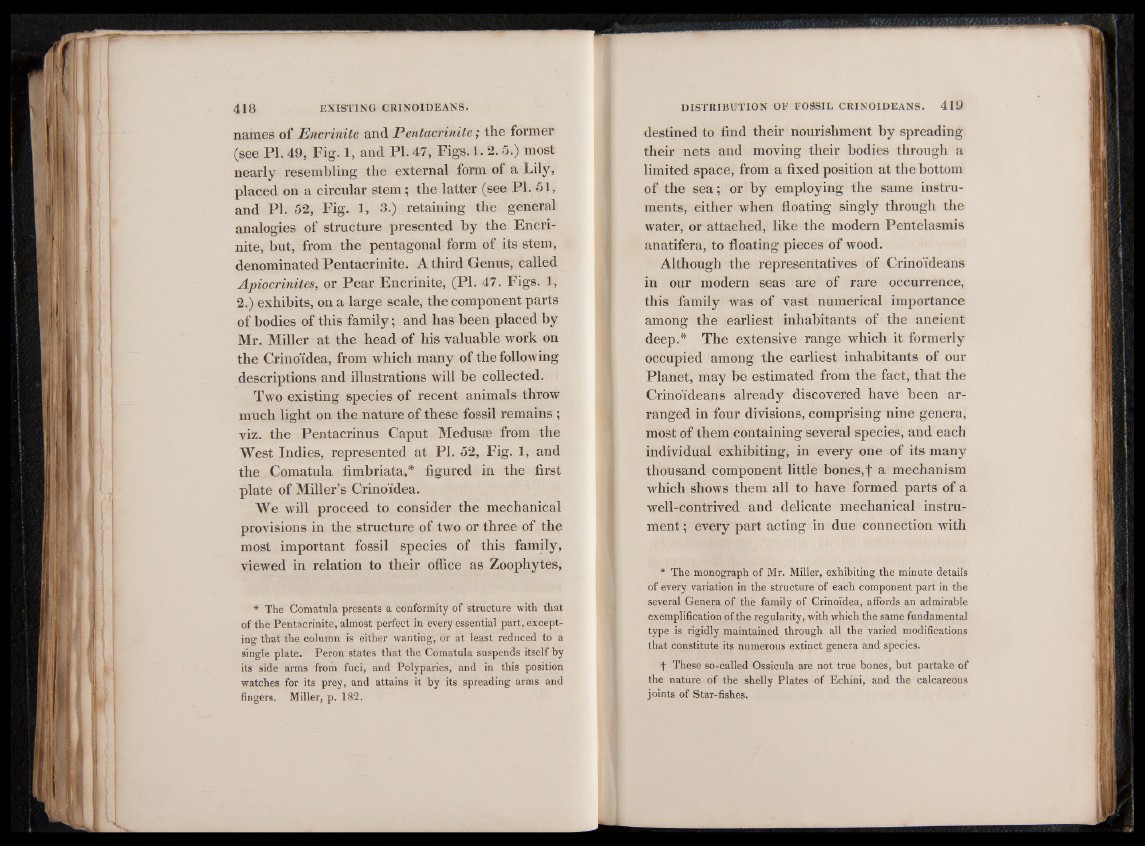
names of Encrinite and Pentacrinite ; the former
(see PI. 49, Fig. 1, and PI. 47, Figs. 1. 2.5.) most
nearly resembling the external form of a Lily,
placed on a circular stem ; the latter (see PI. 51,
and PI. 52, Fig. 1, 3.) retaining the general
analogies of structure presented by the Encrinite,
hut, from the pentagonal form of its stem,
denominated Pentacrinite. A third Genus, called
Apiocrinites, or Pear Encrinite, (PI. 47. Figs. 1,
2.) exhibits, on a large scale, the component parts
of bodies of this family ; and has been placed by
Mr. Miller at the head of his valuable work on
the Crinoïdea, from which many of the following
descriptions and illustrations will he collected.
Two existing species of recent animals throw
much light on the nature of these fossil remains ;
viz. the Pentacrinus Caput Medusae from the
West Indies, represented at PI. 52, Fig. 1, and
the Comatula fimbriata,* figured in the first
plate of Miller’s Crinoïdea.
We will proceed to consider the mechanical
provisions in the structure of two or three of the
most important fossil species of this family,
viewed in relation to their office as Zoophytes,
* The Comatula presents a conformity of structure with that
of the Pentacrinite, almost perfect in every essential part, excepting
that the column is either wanting, or at least reduced to a
single plate. Peron states that the Comatula suspends itself by
its side arms from fuci, and Polyparies, and in this position
watches for its prey, and attains it by its spreading arms and
fingers. Miller, p. 182.
destined to find their nourishment by spreading
their nets and moving their bodies through a
limited space, from a fixed position at the bottom
of the sea ; or by employing the same instruments,
either when floating singly through the
water, or attached, like the modern Pentelasmis
anatifera, to floating pieces of wood.
Although the representatives of Crinoïdeans
in our modern seas are of rare occurrence,
this family was of vast numerical importance
among the earliest inhabitants of the ancient
deep.* The extensive range which it formerly
occupied among the earliest inhabitants of our
Planet, may be estimated from the fact, that the
Crinoïdeans already discovered have been arranged
in four divisions, comprising nine genera,
most of them containing several species, and each
individual exhibiting, in every one of its many
thousand component little bones,t a mechanism
which shows them all to have formed parts of a
well-contrived and delicate mechanical instrument
; every part acting in due connection with
* The monograph of Mr. Miller, exhibiting the minute details
of every variation in the structure of each component part in the
several Genera of the family of Crino'idea, affords an admirable
exemplification of the regularity, with which the same fundamental
type is rigidly maintained through all the varied modifications
that constitute its numerous extinct genera and species.
f These so-called Ossicula are not true bones, but partake of
the nature of the shelly Plates of Echini, and the calcareous
joints of Star-fishes.